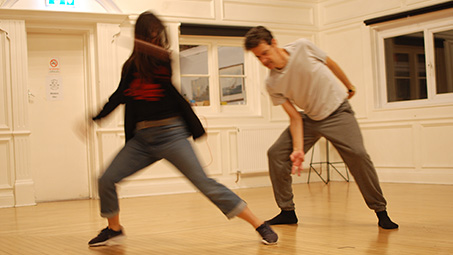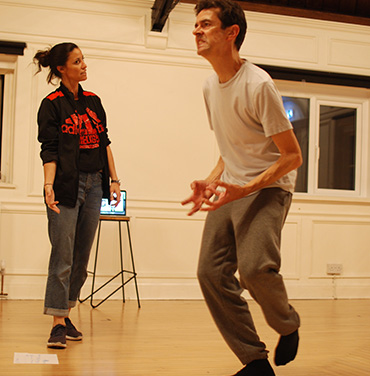We talk to Alex Harland (Devil) and Zoie Golding (choreograper and movement director), who are busy rehearsing for Saturday 16 October’s The Soldier’s Tale…

TS: Alex, how common is it for actors to work with a choreographer? Can you tell us about times when you’ve done this before?
Alex: It’s very common in musical theatre, not so often in straight theatre productions But I have always found choreographers involvement useful in forming character. One particularly memorable example for me was working with Lorna Marshall , an expert in Japanese Kabuki Theatre, when I was playing Richard the Third. She really helped me unlock the character in what was a highly stylised production drawing on elements of Japanese theatre.

TS: Alex and Zoie, can you tell us what happens in rehearsals when an actor and a choreographer work together?
Zoie: For me, it’s very much about understanding the motivation and intention of the scene and how that character might physically interact with other people, props or the space. It’s a collaboration between the script itself, the actor’s interpretation and the physical opportunities that I look for within that frame. When you look at something in the script that is definitely designed as a dance, it’s about working with the actor, who are they, who they are building this character to be and how they may move – what does that feel like in their bodies? So, I try not to teach a routine but use the natural form of that actor to empower and inspire the movement of the dance, so that it becomes really authentic to the character and not a jolty add-on but instead embedding it in the physicality of the character.
Alex: When the relationship works well it is collaborative, with ideas coming from both sides. Working with Zoie has been fruitful because she is not trying to impose set moves on me, but rather attempting to draw out a physical manifestation of my character from my own body.
TS: Alex, in your role as the Devil, without giving too much away before the performances! – how much movement direction/choreographer does it involve?
Alex: A fair amount. There are some parts which are more choreographed. However, Zoie has also helped me in my own forming of the character of the devil and his shape-shifting manifestations.

TS: Zoie, can you tell us a bit about this and how you created it. How does it then guide the creating and work?
This graphic score was created by listening to the music, and just responding to changes. When I hear them, I pick out what resonates with me – is it a bass line beat? Is it a melody or a slight twinkle? I then mark those notes, it’s very organic, I don’t have a language for particular notes, it’s just how I feel: up or down, a spiral, a blip or a dot. I then listen to it again, to see if it makes sense. Creating a visual map of the dance allows me build a structure and see where the louder, quicker and punchier moments are, as well as periods of repetition.
The Soldier’s Tale comes to the Turner Sims stage on Saturday 16 October at 3pm (BSL interpreted) and 8pm (captioned). Book your ticket here
Comments are closed, but trackbacks and pingbacks are open.